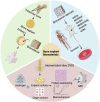Advance in the application of organoids in bone diseases
- PMID: 39291264
- PMCID: PMC11406180
- DOI: 10.3389/fcell.2024.1459891
Advance in the application of organoids in bone diseases
Abstract
Bone diseases such as osteoporosis and osteoarthritis have become important human health problems, requiring a deeper understanding of the pathogenesis of related diseases and the development of more effective treatments. Bone organoids are three-dimensional tissue masses that are useful for drug screening, regenerative medicine, and disease modeling because they may mimic the structure and physiological activities of organs. Here, we describe various potential methods for culturing bone-related organoids from different stem cells, detailing the construction processes and highlighting the main applications of these bone organoid models. The application of bone organoids in different skeletal diseases is highlighted, and current and promising bone organoids for drug screening and regenerative medicine as well as the latest technological advancements in bone organoids are discussed, while the future development of bone organoids is discussed. Looking forward, it will provide a reference for constructing bone organoids with more complete structures and functions and applying them to biomedical research.
Keywords: biomaterials; bone diseases; bone organoids; regenerative medicine; stem cells.
Copyright © 2024 Kong, Yang, Hou, Wang, Li and Song.
Conflict of interest statement
The authors declare that the research was conducted in the absence of any commercial or financial relationships that could be construed as a potential conflict of interest.
Figures





Similar articles
-
Cartilage organoids and osteoarthritis research: a narrative review.Front Bioeng Biotechnol. 2023 Nov 9;11:1278692. doi: 10.3389/fbioe.2023.1278692. eCollection 2023. Front Bioeng Biotechnol. 2023. PMID: 38026876 Free PMC article. Review.
-
The utilisation of biliary organoids for biomedical applications.Front Bioeng Biotechnol. 2025 Jan 7;12:1501829. doi: 10.3389/fbioe.2024.1501829. eCollection 2024. Front Bioeng Biotechnol. 2025. PMID: 39845376 Free PMC article. Review.
-
Human Brain Organoid: A Versatile Tool for Modeling Neurodegeneration Diseases and for Drug Screening.Stem Cells Int. 2022 Aug 25;2022:2150680. doi: 10.1155/2022/2150680. eCollection 2022. Stem Cells Int. 2022. PMID: 36061149 Free PMC article. Review.
-
Future perspectives: advances in bone/cartilage organoid technology and clinical potential.Biomater Transl. 2024 Nov 15;5(4):425-443. doi: 10.12336/biomatertransl.2024.04.007. eCollection 2024. Biomater Transl. 2024. PMID: 39872930 Free PMC article. Review.
-
Organoids as Innovative Models for Bone and Joint Diseases.Cells. 2023 Jun 8;12(12):1590. doi: 10.3390/cells12121590. Cells. 2023. PMID: 37371060 Free PMC article. Review.
Cited by
-
Intelligent Manufacturing for Osteoarthritis Organoids.Cell Prolif. 2025 Jul;58(7):e70043. doi: 10.1111/cpr.70043. Epub 2025 Apr 26. Cell Prolif. 2025. PMID: 40285592 Free PMC article. Review.
-
Protocol for engineering bone organoids from mesenchymal stem cells.Bioact Mater. 2024 Dec 1;45:388-400. doi: 10.1016/j.bioactmat.2024.11.017. eCollection 2025 Mar. Bioact Mater. 2024. PMID: 39687559 Free PMC article.
References
-
- Akiva A., Melke J., Ansari S., Liv N., Meijden R., Erp M., et al. (2021). An organoid for woven bone. Adv. Funct. Mater. 31, 2010524. 10.1002/adfm.202010524 - DOI
-
- Bolander J., Herpelinck T., Luyten F. P. (2020). Periosteum derived cells in skeletal tissue regeneration. Springer eBooks, 101–137. 10.1007/978-3-319-08831-0_6 - DOI
Publication types
LinkOut - more resources
Full Text Sources

